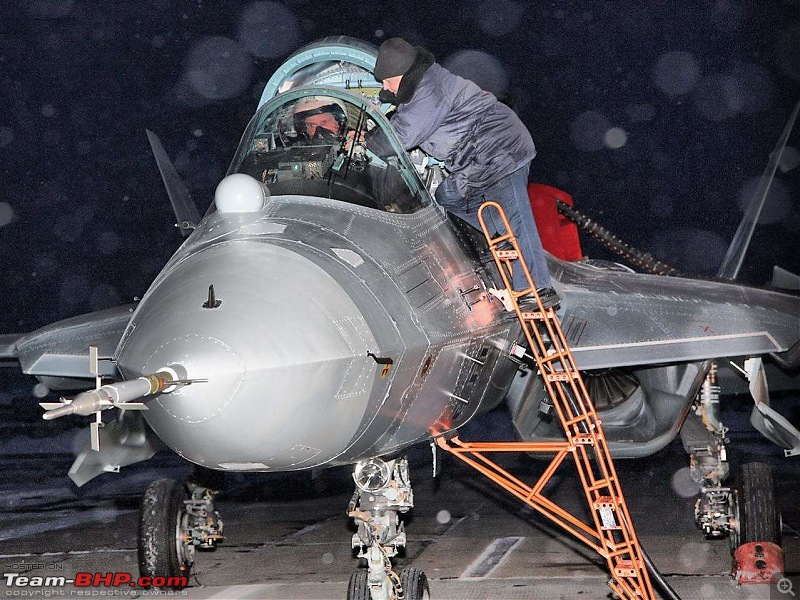| |||||||
| Search Forums |
| Advanced Search |
| Go to Page... |
 |
| Search this Thread |  170,747 views |
| | #91 | ||
| Distinguished - BHPian  Join Date: Aug 2014 Location: Delhi-NCR
Posts: 4,330
Thanked: 72,457 Times
| re: Dassault Rafale, Indian Air Force's new Multi-Role Combat Aircraft! EDIT: MMRCA Evaluation on Page 7 Quote:
Quote:
For us in terms of a qualitative and fundamental shift in air defence capability, in my opinion, this is one of the most significant steps taken after induction of the Sukhoi Su-30MKI 18 years ago and the deployment in c.1969 of the first SAM sites of the IAF along the western border. No one weapon system is a game changer in the absolute sense for any major country facing a comparable adversary. Each new weapon system represents and incremental improvement (hopefully) sometimes the increments are huge. The S-400 is in that category for both China and India. While we may deploy it on our border with China, the Chinese are more interested (my assumption) to deploy on their Eastern seaboard which is their area of maximum perceived threat. It is a substantial increment for them against the Americans, South Koreans & Japanese. They could of course theoretically, with a lot of effort, shift the systems to their side of the Sino-Indian border. Net, net the system is a big asset for both countries. As an aide memoire, for our readers, the mobile S-400 system can engage all types of aerial targets including aircraft, unmanned aerial vehicles (UAVs), and ballistic and cruise missiles within a range of 400 km, at an altitude up to 30,000 metres (100,00 feet). It can track 100 airborne targets, including stealth fighters such as the American built F-35, and engage six of them simultaneously. The S-400 system, which can be deployed within five minutes, integrates a multi-function radar, autonomous detection and targeting systems, anti-aircraft missile systems, launchers, and a command & control centre, and is capable of firing three types of missiles to create a layered defence. The S-400 uses four missiles to fill its performance envelope: the very-long-range 40N6 (400 km), the long-range 48N6 (250 km), the medium-range 9M96E2 (120 km) and the short-range 9M96E (40 km). The S-400 was described by The Economist in 2017 as "one of the best air-defence systems currently made". In the IAF the S-400 will augment the Israeli SPYDER missile system used for quick reaction short and medium range defence in the 0 to 50 kms range. The SPYDER system is both a point defence and an area defence system using two different missiles one guided by radar and the other passively by infra-red. Before a member asks the question – where surface-to-air missiles go the Russians are up there with the best i.e. the Israelis. American, British & European land based (as opposed to ship based) systems in regular squadron use in large numbers while good in parts are simply not in the same league as Russia and Israel when operated in real world environments. Last edited by V.Narayan : 10th August 2020 at 10:09. | ||
| |  (13)
Thanks (13)
Thanks
|
| The following 13 BHPians Thank V.Narayan for this useful post: | Alfresco, dragracer567, himanshugoswami, kkstile, pranavtengshe, R2D2, RaviK, skanchan95, spgv, Sutripta, vibbs, whitecloud, whitewing |
| |
| | #92 |
| Senior - BHPian Join Date: Dec 2007 Location: Gurugram
Posts: 7,971
Thanked: 4,809 Times
| re: Dassault Rafale, Indian Air Force's new Multi-Role Combat Aircraft! EDIT: MMRCA Evaluation on Page 7 I hear rumours that the next tranche of five may be coming by the end of September. I expect it to be located in Hasimara. There may not be more twin seaters in this lot. We have already got three (out of six). |
| |  ()
Thanks ()
Thanks
|
| | #93 | |
| BHPian | re: Dassault Rafale, Indian Air Force's new Multi-Role Combat Aircraft! EDIT: MMRCA Evaluation on Page 7 Quote:
Here's a closer look at the system in question.  The details of the system are explained here. Smartcat had shared the brochure in a post, sometime earlier in the thread on Combat Aircrafts of IAF.  I came across some detailed pictures of the engine nozzle. Quite a bit of engineering.   Source: Luc Colin's page on PrimePortal. Amazing pictures of the Rafale there. Surprisingly, the Marine Rafale doesnt seem to have this equipment. 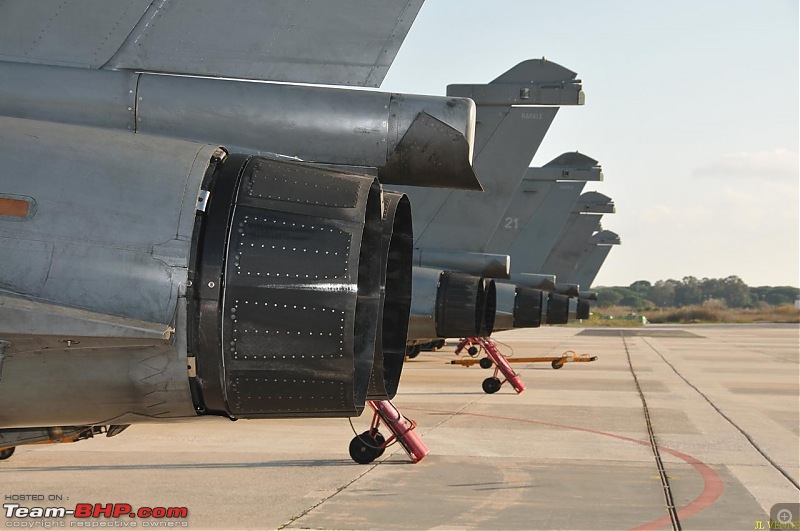 Last edited by Maveryq : 10th August 2020 at 12:36. Reason: added a picture | |
| |  (8)
Thanks (8)
Thanks
|
| The following 8 BHPians Thank Maveryq for this useful post: | Alfresco, AlphaKilo, black_rider, Foxbat, R2D2, Sutripta, V.Narayan, vibbs |
| | #94 | ||||
| Senior - BHPian Join Date: Aug 2017 Location: Leeds
Posts: 1,197
Thanked: 2,952 Times
| re: Dassault Rafale, Indian Air Force's new Multi-Role Combat Aircraft! EDIT: MMRCA Evaluation on Page 7 Quote:
Quote:
The other programme is their deep penetration strategic bomber programme, the Xian H-20. Right now, they only have the geriatric H-6 that's soldiering on admirably as a bomb truck but it isn't something to give the IAF pause. The day the PLAAF have their own equivalent to the B-2 Spirit, in that it's LO, has a large payload capacity and significant range (they'd likely want this to target Guam primarily - but the alarming corollary is that it could let them venture far deeper into Indian airspace), it would give them a tool to get at a far greater subset of Indian installations. This is the most worrying programme to me. Quote:
Quote:
From what we know so far there are a couple of absolute must haves for a platform to achieve LO:
| ||||
| |  (15)
Thanks (15)
Thanks
|
| The following 15 BHPians Thank ads11 for this useful post: | aghate, Alfresco, alpha1, dragracer567, DrPriyankT, FlankerFury, Jeroen, R2D2, Romeo_Mike, Shome, skanchan95, Sutripta, V.Narayan, v1p3r, vibbs |
| | #95 | |
| BHPian Join Date: Sep 2011 Location: Mumbai/Gurgaon
Posts: 385
Thanked: 489 Times
| re: Dassault Rafale, Indian Air Force's new Multi-Role Combat Aircraft! EDIT: MMRCA Evaluation on Page 7 Quote:
http://fullafterburner.weebly.com/ae...th-gamechanger And an excerpt from Wiki probably copied from the same source | |
| |  (4)
Thanks (4)
Thanks
|
| The following 4 BHPians Thank Shome for this useful post: | Jeroen, R2D2, Sutripta, V.Narayan |
| | #96 | |
| Senior - BHPian Join Date: Aug 2017 Location: Leeds
Posts: 1,197
Thanked: 2,952 Times
| re: Dassault Rafale, Indian Air Force's new Multi-Role Combat Aircraft! EDIT: MMRCA Evaluation on Page 7 Quote:
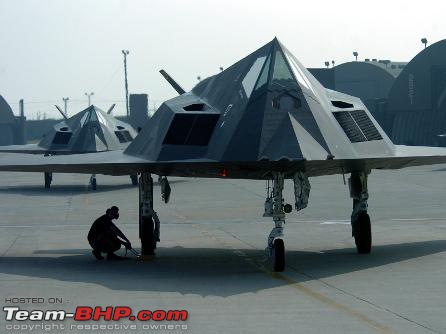 When I think of some form of radar blocker, I would assume they'd at least try and use the sort of mesh/grille approach we saw on the Nighthawk above. The key here is that the Su-57 so far has displayed very little of the sophisticated solutions that one has come to see on the chunky F-35 or it's older brother F-22, even the J-20 for that matter. Now, this is both a consequence of the fiscal realities Russia faces and the handicap that'll be to the development programme, but it's also emblematic of how the Russians undoubtedly have fallen behind in the development race. What the Russians still do best is find the best utilitarian compromises for the most part, especially when you discount all the high falutin programmes that Putin mostly touts as bluster more than anything. We see that in their nuclear subs, their handy little corvettes and their missile tech. | |
| |  (3)
Thanks (3)
Thanks
|
| The following 3 BHPians Thank ads11 for this useful post: | Jeroen, skanchan95, V.Narayan |
| | #97 |
| BHPian Join Date: Jan 2020 Location: Bangalore
Posts: 51
Thanked: 152 Times
| re: Dassault Rafale, Indian Air Force's new Multi-Role Combat Aircraft! EDIT: MMRCA Evaluation on Page 7
Thank you Sir for yet another awesome and enlightening read. Your essays are worth a re-read for me being both informative and enjoyable. Can I request you for a comparative study on the different aircrafts that IAF were considering for the MMRCA program before choosing the Rafale. I was fortunate enough to witness the Rafale at close quarters (almost touching distance) and in action too at Aero India 2019 in Blr. Attaching few snaps. 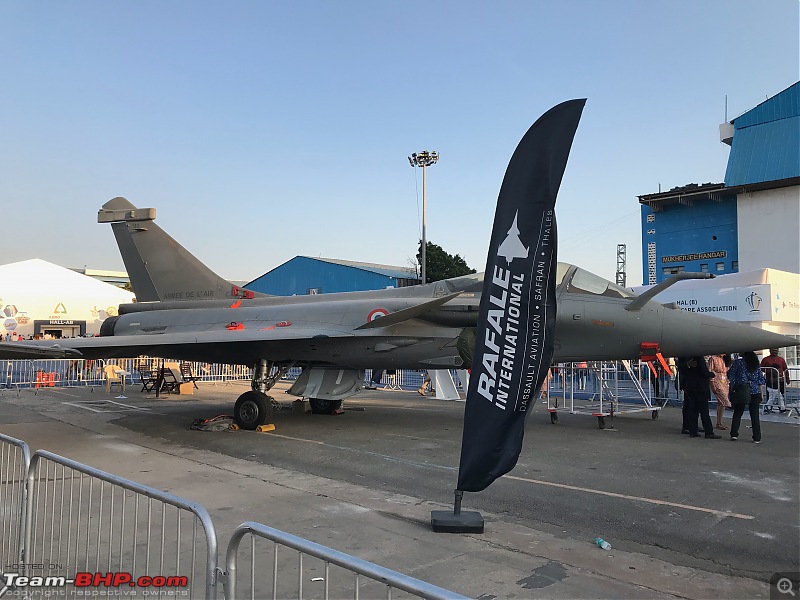     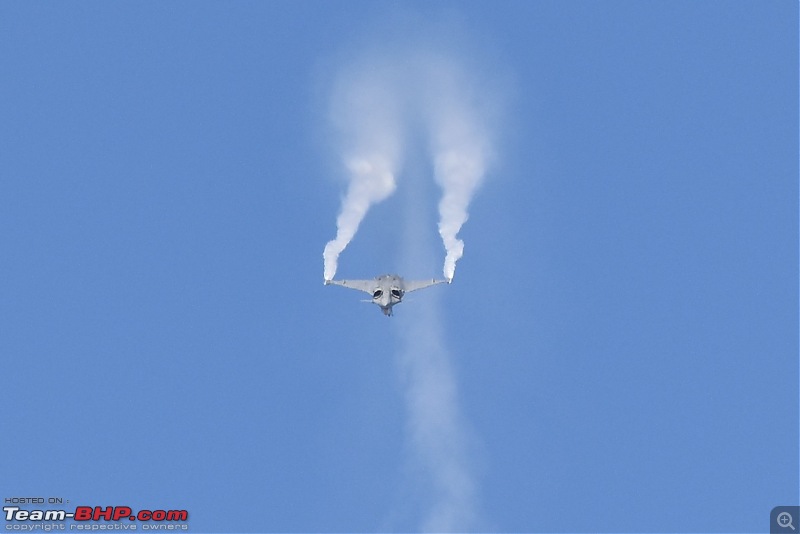  |
| |  (8)
Thanks (8)
Thanks
|
| The following 8 BHPians Thank Anduril for this useful post: | akshay380, blackstallion76, FlankerFury, R2D2, Red Liner, Shome, skanchan95, V.Narayan |
| | #98 | ||
| BHPian Join Date: May 2009 Location: NYC / Lucknow
Posts: 706
Thanked: 4,145 Times
| re: Dassault Rafale, Indian Air Force's new Multi-Role Combat Aircraft! EDIT: MMRCA Evaluation on Page 7 Quote:
Quote:
| ||
| |  (5)
Thanks (5)
Thanks
|
| The following 5 BHPians Thank Foxbat for this useful post: | dragracer567, DrPriyankT, FlankerFury, skanchan95, V.Narayan |
| | #99 |
| BHPian Join Date: May 2019 Location: Haridwar
Posts: 171
Thanked: 1,047 Times
| re: Dassault Rafale, Indian Air Force's new Multi-Role Combat Aircraft! EDIT: MMRCA Evaluation on Page 7 Recent Sat pics appearing on social media for 2 J-20 arrival at Hotan airbase near SSN laddak. Things surely doesn't seems to be cooling down. Anyway, even if J20 isn't as good as western 5gen crafts ( these reports have obvious origins in west), it still will be a league above 4+ gen fighter atleast in RCS. As already discussed, Radars have a tough time detecting ( more importantly generating quality of data for targeting) in mountainous terrain, a stealth aircraft flying 1000km an hour will probably give only a minutes warning for command and control to act that too if it is actually detected. Most of the time Elint platforms will quite accurately predict location of air defence radars, accurately enough to escape their envelope, probably not enough to target them, feed the information to strike package beforehand so that best radar evasion can be performed by flying in between diminished radar envelopes. I guess for J20, High value target like Radars, Awacs and tankers will be primary targets not other fighters. |
| |  (1)
Thanks (1)
Thanks
|
| The following BHPian Thanks Alka panwar for this useful post: | vibbs |
| | #100 |
| Distinguished - BHPian  Join Date: Aug 2014 Location: Delhi-NCR
Posts: 4,330
Thanked: 72,457 Times
| re: Dassault Rafale, Indian Air Force's new Multi-Role Combat Aircraft! EDIT: MMRCA Evaluation on Page 7 MMRCA Competition - Evaluation of 6 Combat Fighters Caution: Long read The MMRCA competition was an evaluation between 6 competing aircraft conducted over 2008-2011. It was to best of my knowledge the most thorough evaluation of today’s fast jet multi-role fighters. No other international selection process, by any other Air Force, comes close. The six aircraft as most readers will recall are – Eurofighter Typhoon, Dassault Rafale, Boeing Super Hornet F-18E, Saab Gripen, Lockheed F-16IN and MiG-35. Of these, all are in squadron service with their respective countries of origin. Only the MiG-35 is at a prototype stage and unlikely to be a part of the Russian AF. This post is merely my personal opinion as an amateur. What you read on social media or Wikipedia might differ. I am evaluating these on a few criterion of the hundreds available. On several vital attributes, understandably, very little real information on real performance is available publicly; attributes such as, AESA radar, IRST {Infra Red Search & Track}, weapon accuracy & performance in real world conditions, the fly by wire controls, the integrated nav-attack & weapons management systems etc. Going by what little I have read in journals the AESA radars are best in Rafale & F-18E. The sheer breadth of accurate weapons would be best with the Rafale, F-18E & Eurofighter Typhoon followed very closely by the F-16. Gripen needs too much integration for our needs and the MiG-35 is an orphan in its own land. Always be careful of a weapon not yet adopted in its own land unless we want to be the guinea pigs at whose cost the ‘D’ of R&D is expended over 10 years thereafter. The French fully and Eurofighter & Saab hesitantly were willing to share their software for us to optimize and customize. The Americans have never done it except for their closest allies, the Japanese and the British. The Russians have had a very poor track record on this over the MiG-21 Bison and Su-30MKI programmes. We’ll look at how these 6 stack up on 13 characteristics in three broad buckets – (1) Wings & Flying; (2) Engines, Power, Performance; (3) Weapon Payload and Endurance. Here we are not evaluating line by line top speed vs top speed, claimed range vs claimed range - we'll leave that for our journalists and social media warriors. We’ll go one notch deeper at the underlying character of the airplane which ultimately determines these brochure figures. Wings & Flying  The wings are the starting point of an aircraft design. An aircraft is a pair of wings with an engine fitted to them. The wing lays out the upper and lower limits of what that aircraft can or cannot do and how well. The engines make sure the wings of the fighter are allowed enough energy to fulfill those limits. Bear in mind we are not evaluating these 6 aircraft on wing shape, aspect ratios, thickness, flight surfaces etc. On these attributes really all six have marvelously designed wings and broadly in the same league of excellence. Let’s start with just the size of the wing. This determines how much work can the wing do and how much reserve capacity of ‘wingy’ work it has to fly at the limits of its envelope. The load it can carry, how sharply it can turn with that load for a given power, how slow it can fly with stability etc. Mind you we are only talking of size here – not shape, aspect ratio, sweep angle or anything else – just size. A small wing area by sheer definition puts real limits on payload, manoeuvrability with payload, lift reserves, and simpler items like fuel capacity and literally room to fit a vast weapons mix with safe separation. For the MMRCA specs my opinion is we need a minimum wing size of ~450 sq feet. 400 is quite at the margin. 500ish is outstanding. Below 400 is a no-no; no matter how well designed a small wing simply doesn’t have enough ‘wing’ to get the job done. Here the Typhoon, Rafale & F-18E score. The Gripen & F-16IN simply don’t make the cut. The size is a function of what the wing (i.e. aircraft) was originally designed for. The MiG-35s parent i.e. the MiG-29 and F-16 were originally the light fighters of their times for USSR and USA. It shows in their wing sizes. The Gripen was designed at the start to be a light multi-role fighter. The key word being light. It reflects in the wing. Over the life of an aircraft with upgrades you can increase weight, change the shape of the nose, stretch the fuselage, fit more powerful engines, but you cannot really redesign the wing. If you do that you might as well take 7 years off and design a whole new aircraft. The F-18, Typhoon & Rafale have been designed at the outset to be a MRCA hence their larger wings. Then comes good old fashioned wing loading. The measure of lbs per sq foot tells us how much reserve flying energy a wing has at a given weight. A Boeing 747 flying typically loaded with passengers, cargo & fuel and having just reached its cruise altitude would have wing loading of say around 140 lbs/ sq foot. For simplicity of this explanation let’s take this as a datum. At this loading it can fly straight and manoeuvre gently. So, if a fighter has a wing loading of say 75 lbs/ sq foot it has that reserve of 65 units of flying energy for hard manoeuvres. For fighters the wing loading at clean weight indicates its manoeuvre energy surplus and the loading at maximum take-off weight tells us how well it can fight when carrying a full weapons payload for a strike deep inside enemy territory. The figures are all for clean weight. For the MMRCA a loading below 75 is ideal. Between 75 and 85 is still ok. Above 85? – what are you smoking. Above 90 is like the wing loading of the Sepecat Jaguar a dedicated attack aircraft with little pretensions of being an interceptor! Rafale, Typhoon and Gripen score here. And then we come to canards. Each generation of fighters has had a game changing wing design attribute. Swept wings in the late 1940s and brought in transonic speeds. Delta wings came in the late 1950s/early 1960s – they gave speed, acceleration with manoeuvrability; large leading root extensions started appearing in the late 1970s/early 1980s – they added to manoeuvrability at high angles of attack and brought sanity to fighter landing speeds. All flying canards came in late 1980s-1990s. They bring in the super manoeuvrability we are now familiar with at air shows. Today, buying a fighter without canards is like buying one without a delta wing in 1965. Tyhoon, Gripen & Rafale score here. As we see the Rafale & Tyhoon score on all attributes. Is it any surprise that they were the two finalists? Engines and Power  For the mission profile of a multi-role high endurance interceptor cum strike cum air dominance aircraft defined by the IAF you really need a base minimum of 95kN to 100kN of dry thrust. At the very least 90kN. Dry thrust i.e. without reheat determines the sustained power available on a high endurance mission. The reheat thrust is important for short manoeuvres and exits but it is the dry thrust that decides how well the aircraft performs for 95%+ of the flight time. If engine dry thrust isn’t enough you may still meet speed, climb & acceleration parameters but it will be at the expense of range, payload & avionics you can carry. Rafale, F-18, Typhoon & MiG-35 cross the bar here. Given the complexity and lethality of military air operations and the enormous cost per aircraft (easily 3 figures $ million apiece) you don’t want to lose the machine due to engine failure, a bird hit or a military hit. You want that $ 100+ million machine getting back. More so given that fighters today, with upgrades serve 40+ years it is a national asset to preserve. Twin engines are definitely preferred. Power loading or power to weight ratio determines sustained manoeuvrability, climb, acceleration, escape speed, top speed. For our purposes the clean power loading should be 1.00 or more. At the most we can settle for 0.95 but nothing less than that will do. For power loading at maximum take-off weight 0.6 would be my cut off number. This figure indicates how much reserve power a fighter has when flying fully laden with fuel and weapons. All the contenders score here except the Gripen. If you are allowed to know only one data item on a fighters performance to determine which contender to eliminate on performance then ask for the climb rate. Its like an experienced car mechanic or lover listening to the sound of the IC engine to determine if all is well. Climb rates have a raw power sense about them. It indicates among others how much of surplus energy the aircraft has. The same extra energy is available for turning, twisting, accelerating etc. You may not be able to outrun a missile but with luck you could out climb it in a sustained full power climb. For our purposes a climb rate below 250 is the minimum. 275 is wonderful. 300 is ecstatic. The Gripen has consistently not declared its climb rate! Draw your own conclusions. My estimate is that it is around 225 metres per second. Only the Tyhoon has meaningful super cruise with an air superiority weapon configuration. Rafale makes the claim but I’d take it with a pinch of salt. The Rafale could super cruise, probably, with two air-to-air missiles and 3/4th internal fuel but that is not realistic military configuration. Typhoon, Rafale, MiG-35, F-18 meet all the criterion here. Though one needs to be very concerned about reliability & spare parts availability of the MiG’s Klimov engines. In this department the Typhoon scores head and heels above the rest. Payload  External payload is for fuel, weapons, electronic guidance & defense pods, and reconnaissance pods. We can have more of one at the expense of the other. The number of hardpoints tells us the flexibility available to the mission planner to accommodate ground attack weapons+ external fuel + electronic countermeasure pods + target designation pods + air-to-air missile for self defense. For this role as a MRCA the Gripen’s external payload of 5300 kgs is way too little. And the MiG-35’s 7000 kgs is acceptable. Their hardpoints of 10 and 9 are okay. Rafale at 14 and Typhoon at 13 are excellent. 11 of the F-18 and F-16 are also fully acceptable. Each country of supplier will largely determine the weapons fit. The French have proved to be co-operative and unfussy about integrating weapons of other origin with their designs when we sought it. We assume the Europeans and Swedes would do likewise but it remains an assumption to be proven. For a couple of years after 1998 due to Pokhran-II the British choked supplies for the Sepecat Jaguar. After Pokhran-I in 1974 they choked supplies for the Orpheus engine and other aircraft in our inventory then. The Russians we understand, their weapons are solid but their attitudes today are wobbly. The Americans have a full suite of competent weapons, they won’t in practise want to integrate too much outside their own. I am not going here into political factors as that is a whole different story. Radius of action is the most fudged figure on the internet. So, we look at other signs like fuel fractions, total fuel capacity, number of wet pylons to determine the quality of combat radius in real life. Fuel fraction is the ratio of internal fuel to clean take-off weight. At 0.30 30% of the clean take-off weight is of internal fuel. This is the ideal minimum and 0.33 the ideal maximum. Between this range the fighter aircraft’s structure is carrying its optimum volume of fuel. Above 0.33 the structural strengthening needed to carry the extra fuel acts as a penalty and the fuel ends up not adding any significant range. That extra fuel is merely carrying its own weight & extra structural weight to the target. Here we see the Rafale at the upper end and F-18, Typhoon & MiG-35 at the lower of this acceptable range. F-16 and Gripen are simply not carrying the internal fuel needed to help maximize range. Rafale & F-18 come out on the top. The total fuel figure of the Typhoon I am sure is under stated. Typhon’s figure looks 1.5X too low for its size, weight & power. We’ll include it with the Rafale & F-18. While the MiG-35 is at an acceptable 0.30 of fuel fraction its thirsty engines need more than 9000 kgs for a really long strike sortie flown lo-lo-lo. Each reader can draw his/her own conclusions. I’ve included my views under the photos of the 6 contenders. All photos from Wikipedia 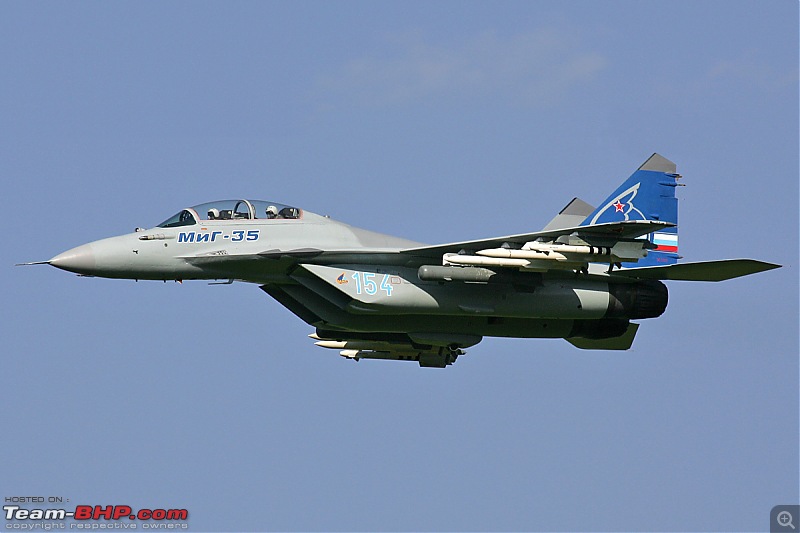 MiG-35, Russia: Rule 1: Never buy a weapon not in use by its home country. Rule 2: When in doubt refer to Rule 1. The MiG-35 is a re-branded MiG-29M. I love the MiG bureau’s aircrafts but this is not the horse (or is it eagle here) to back for the next 50 years.  Saab Gripen, Sweden: Beautifully engineered. Pioneered flying canards in 1988 for combat fighters*. Pioneered fully integrated computerized systems to manage all aspects of flying and attacking. In 1988 it introduced the concept {now common} of switching from one software to another to fly a different mission profile. A product of Swedish engineering excellence. Sadly it is too small. It is broadly in the weight-power range of our Tejas. Great aircraft, wrong competition! 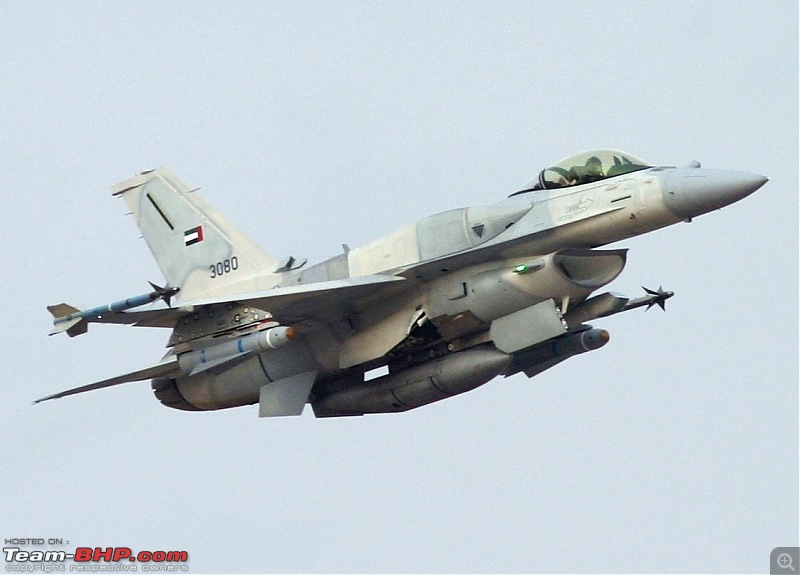 Lockheed F-16IN, USA: A late generation F-16 customized for India. The F-16 is a great aircraft in many respects. For me, single engine, used by Pakistan, smallest wing size are big detractors.  Eurofighter Tyhoon, European: Now the selection gets very close. Where sheer fighter flying, climbing, twisting & turning is given this is probably as good if not better than the Rafale. I’d put it ahead of the Rafale – both fully exceed criterion and the Typhoon does it better. Weapons mix is similar. Quality on controls, weapons management must be neck to neck. Only thing is the Typhoon was first designed as an interceptor and air dominance aircraft. The attack capability blossomed later. That is a factor but not a detractor. Its AESA radar suite is probably less refined than the French. The political risk of dealing with multiple European nations any one of which could toss in sanctions is an enduring concern.  Boeing Super Hornet F-18E, USA: In terms of sheer weapons fit this is probably the best especially if we could integrate the Meteor AAM & SCALP cruise missile to it. If we were in bed with the Americans I’d root for the F-18E. Of all the OEMs here, Boeing & Dassault are the two we have the best working relationship with. It could also then be our naval fighter. 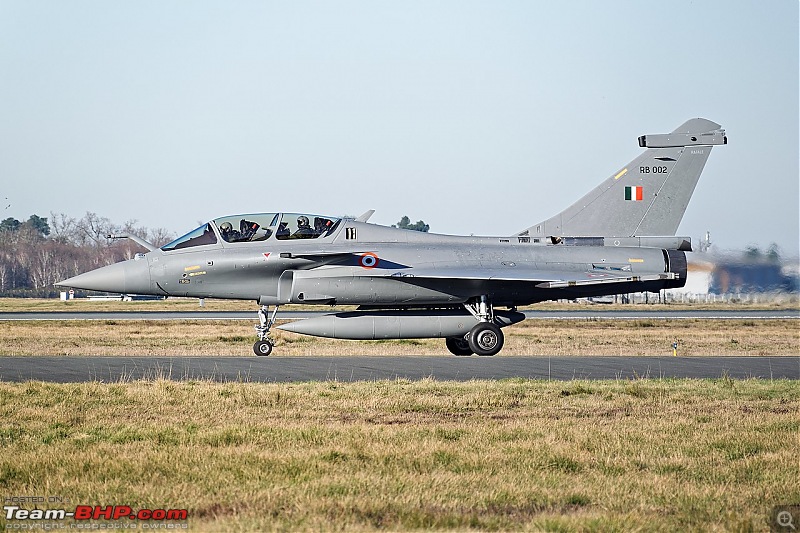 Dassault Rafale, France: The IAFs choice. My choice too. I hope the Indian Navy pick it too and we put it into production. Dreams! Jai Hind. Last edited by V.Narayan : 23rd August 2020 at 13:29. |
| |  (99)
Thanks (99)
Thanks
|
| The following 99 BHPians Thank V.Narayan for this useful post: | 1.2TSI7DSG, aashishnb, ach1lles, adwaith, aghate, Alfresco, alpha1, alphadog, AlphaKilo, AmitRavi07, anand.shankar, Anduril, aqualeo2040, ArizonaJim, ashking101, BackInTheFold, Capricorn, CARDEEP, CarManMotorcycl, catchjyoti, dealer, DiMaGo, dragracer567, DrPriyankT, drrajasaravanan, F1-Addict, fache89, fhdowntheline, FlankerFury, gauravanekar, gb97ce6, GTO, Hayek, Herschey, highlander, highway_star, himanshugoswami, HsekarK, icar, isandy, jayakumarkp, JustStarted, kamilharis, keroo1099, Keynote, kkstile, Kool_Kid, Kuldeep31, kunaldhami, kutts, lovetorque, MaddyCrew, Motard_Blr, Night_Fury, NiInJa, Nitronium, PetrolRider, Ph03nix, PM - B, pranavtengshe, PraNeel, R2D2, Rachit.K.Dogra, rajvardhanraje, Ravi Parwan, Reinhard, RoboCop13, roshithr, rrsteer, RWD, saisree, sai_ace, SamarthMehrotra, sarathlal, sharktale, Shome, Shrayus_shirali, Shreyans_Jain, skanchan95, somspaple, sooshan, spgv, sridhar-v, stormdRider, Sutripta, swapnil.awate, The Rationalist, thecarguy, theflyingguy, thewhiteknight, Torino, Tucker48, v1p3r, vaasu, vamsi.kona, vibbs, Vijin, whitecloud, whitewing |
| | #101 |
| Senior - BHPian Join Date: Oct 2004 Location: !!!!
Posts: 2,326
Thanked: 2,693 Times
| Re: Dassault Rafale, Indian Air Force's new Multi-Role Combat Aircraft! EDIT: MMRCA Evaluation on Pa |
| |  (5)
Thanks (5)
Thanks
|
| The following 5 BHPians Thank himanshugoswami for this useful post: | Alfresco, gauravanekar, Shome, Shrayus_shirali, V.Narayan |
| |
| | #102 | |||||||||
| Senior - BHPian Join Date: Jul 2009 Location: Calcutta
Posts: 4,665
Thanked: 6,233 Times
| Re: Dassault Rafale, Indian Air Force's new Multi-Role Combat Aircraft! EDIT: MMRCA Evaluation on Pa
In our dumbed down age where a thirty sec sound bite/ video clip is about the max we can digest at one go, this is too much, information overload.  Quote:
Quote:
Quote:
Quote:
Quote:
Quote:
Quote:
What about advantages/ disadvantages of drop tanks? Quote:
Quote:
Letting aside the importance or otherwise of dogfighters, how would these aircraft (and the Tejas) fare in the dogfighter role? Would the Swedes be interested in contract design work? Sutripta Last edited by Sutripta : 23rd August 2020 at 20:30. | |||||||||
| |  (5)
Thanks (5)
Thanks
|
| The following 5 BHPians Thank Sutripta for this useful post: | Alfresco, gauravanekar, kkstile, lovetorque, V.Narayan |
| | #103 |
| BHPian Join Date: Jan 2020 Location: Bangalore
Posts: 51
Thanked: 152 Times
| Re: Dassault Rafale, Indian Air Force's new Multi-Role Combat Aircraft! EDIT: MMRCA Evaluation on Pa
Thank you Sir for another enlightening post and keeping my request. I was actually confused between the shape of Typhoon and Rafale since they both looked so similar. Had to read up on wikipedia to know Rafale emerged as an offshoot of the Eurofighter program after France opted out. Wikipedia schematics also showed the subtle design design differences between the two like Typhoon's canards placed slightly ahead and Rafale's delta wings sloping down (don't know the aeronautical term for that  ) )Image Source : Wikipedia 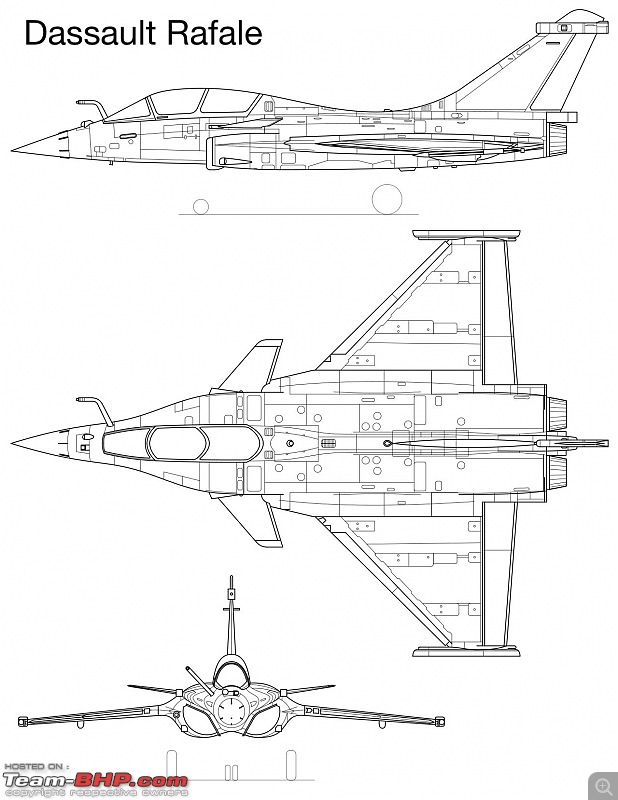  |
| |  (2)
Thanks (2)
Thanks
|
| The following 2 BHPians Thank Anduril for this useful post: | blackstallion76, V.Narayan |
| | #104 |
| BHPian Join Date: Oct 2012 Location: Chennai
Posts: 828
Thanked: 3,482 Times
| Re: Dassault Rafale, Indian Air Force's new Multi-Role Combat Aircraft! EDIT: MMRCA Evaluation on Pa The biggest issue with this bid though was as Mr Narayan puts it the Gripen and F16 are entirely different categories. They are primarily short field capable point defense fighters with exceptional dog fighting capabilities. The larger, Rafale, Hornets are multi role fighters that lead strike packages into enemy territory. On the former Point Defense role, the govt has taken the right call to push larger orders of Tejas as this will bring with it economies of scale and improve our military industrial complex. Our mix should be Tejas for point defense role and larger numbers of Rafale+ Sukhoi 30 mki for the multi role fighters. |
| |  (2)
Thanks (2)
Thanks
|
| The following 2 BHPians Thank Stribog for this useful post: | V.Narayan, vibbs |
| | #105 |
| Senior - BHPian | Re: Dassault Rafale, Indian Air Force's new Multi-Role Combat Aircraft! EDIT: MMRCA Evaluation on Pa I am closely following this topic for the last few weeks. Thanks for this great post. Describes the pros and cons of each aircraft so clearly. I think 36 aircraft is a separate Naval requirement for the new aircraft carrier INS Vikrant. I think Indian Navy needs folding wings for the operations on air craft carrier, currently Rafale doesn't have this feature ? I think the Navy already started trials of FA 18 Super Hornet and its wings can be folded. Instead of this new tender, shouldn't we immediately restart the super sukhoi program to upgrade the SU-30 MKI engines and avionics to make it at par with SU-35 ? We already have 260+ SU-30 MKI If Rafale were to be made locally, who would make it in India ? I think this is very unlikely. If local manufacturing is a main criteria , I think Lockheed Martin and Boeing are better equipped. What is your opinion of SU-57 ? Though it is not on offer as per of the new tender. Last edited by F150 : 24th August 2020 at 11:50. |
| |  (4)
Thanks (4)
Thanks
|
| The following 4 BHPians Thank F150 for this useful post: | gauravanekar, Jeroen, V.Narayan, vibbs |
 |







